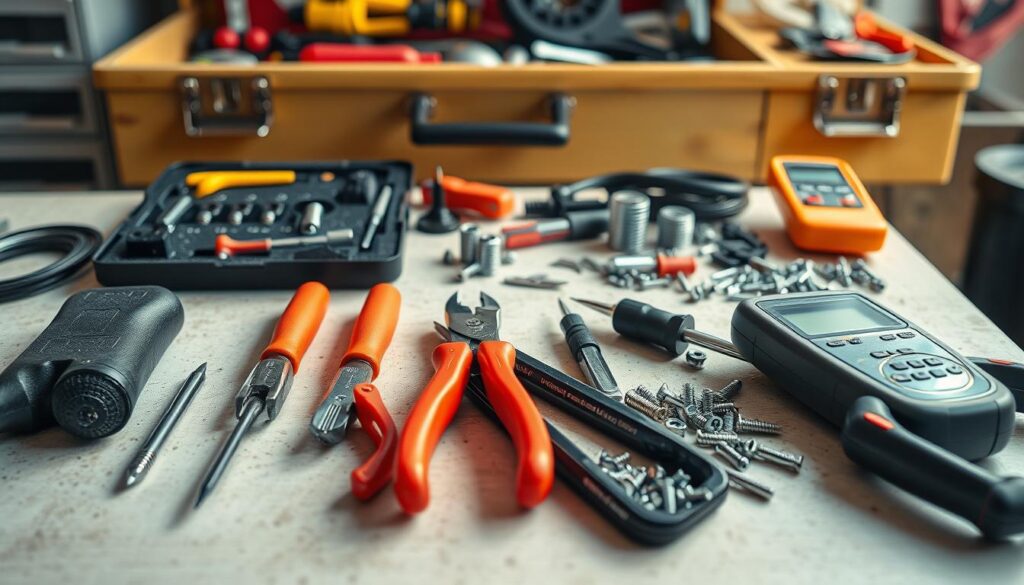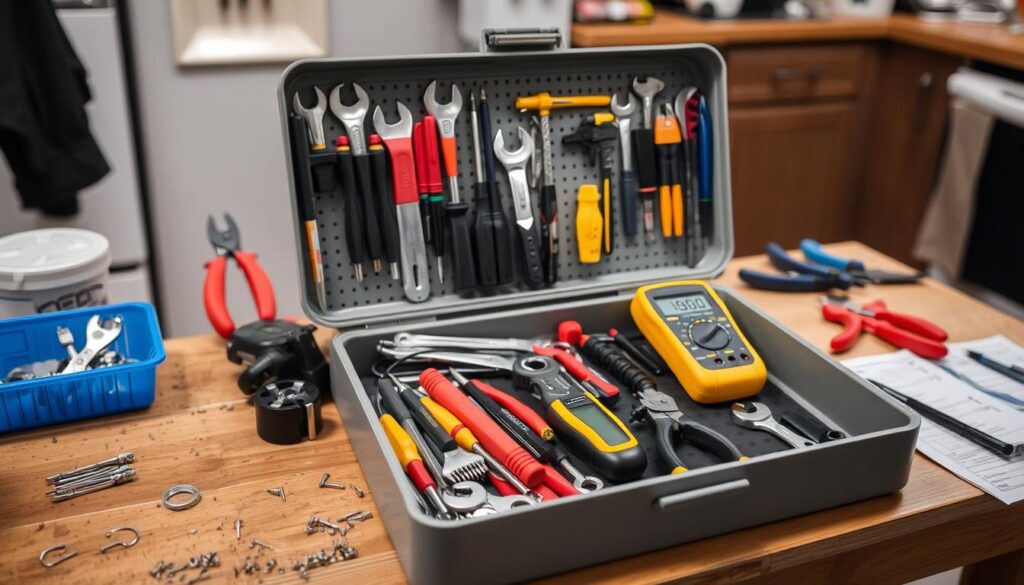Is your fridge not working right? Or maybe your washing machine is giving you trouble? You’re not alone. Appliance problems are common, but they don’t have to cost a lot. This guide will help you fix common issues yourself.
It covers simple fixes and when to call a pro. We’ve got everything you need.
Keeping your appliances in good shape is more than just fixing them when they break. It’s about knowing how they work and keeping them running well. With the right tools and a little knowledge, you can save money and time on many repairs.
Let’s look at the top 10 appliance problems and how to solve them.
Understanding Home Appliance Maintenance Basics
Keeping your home appliances in top shape saves money and extends their lifespan. Let’s explore the essentials of DIY repairs, safety measures, and when to seek professional help.
Essential Tools for DIY Repairs
Every homeowner should have a basic set of home appliance tools. These include:
- Screwdrivers (flathead and Phillips)
- Pliers
- Multimeter
- Adjustable wrench
- Flashlight

Safety Precautions Before Starting
Repair safety is crucial when working with appliances. Always unplug the device before starting any work. Wear safety glasses and gloves to protect yourself from potential hazards. If you smell gas or see sparks, stop immediately and call for professional repair services.
When to Call a Professional
While DIY repairs can save money, some issues require expert attention. Contact professional repair services if:
- The appliance involves gas lines
- You lack the necessary tools or skills
- The repair involves complex electrical work
- The appliance is still under warranty
Remember, your safety comes first. If you’re unsure about a repair, it’s best to consult with a professional technician.
Refrigerator Troubleshooting Guide
Your fridge is key in the kitchen. It needs quick fixes when it breaks. This guide helps you solve common fridge problems at home.
Temperature Control Issues
Is your food going bad too fast? Check your fridge’s temperature control. It should be between 37°F and 40°F for best cooling. If it’s not working, look at the door seals.
Loose seals let cold air out. Clean them with warm, soapy water and dry them well.

Ice Maker Problems
Start ice maker troubleshooting by checking the water supply. Make sure the water line isn’t kinked or frozen. If ice cubes are small or hollow, it might be low water pressure.
Clean the water filter if your fridge has one. For ongoing problems, the ice maker might need to be replaced.
Strange Noises and Solutions
Odd fridge sounds can worry you. A loud humming means the compressor is working too hard. Clean the condenser coils, usually found behind or underneath the fridge.
Rattling noises might mean a loose drip pan or fan blade. Tighten any loose parts you find. If strange noises keep happening, call a pro for fridge repair.
“Regular maintenance keeps your fridge running smoothly and can prevent costly repairs down the line.”
Always put safety first when fixing things yourself. Unplug your fridge before working on it. If you’re not sure about anything, don’t be afraid to call a professional technician.
Common Appliance Repairs for Washing Machines
Washing machines are key in our homes. But, they can have problems. Let’s look at common issues and how to fix them at home.
Drainage Problems
Drainage issues in washers are annoying. First, check the drain hose for kinks or blockages. Also, clean the pump filter often to avoid clogs.
If water won’t drain, look at the pump. It might be damaged or blocked.
Spin Cycle Issues
Spin cycle problems usually come from worn parts. Check the drive belt for wear. If it’s damaged, replace it.
A faulty lid switch can also stop spinning. Use a multimeter to test it. Replace it if it’s not working right.
Unbalanced Load Solutions
Unbalanced loads cause too much vibration and noise. Make sure clothes are spread out evenly in the drum. For ongoing problems, check the suspension springs and shock absorbers.
Replace these parts if they’re worn out. This will help your machine run smoothly again.
- Level your washing machine using adjustable feet
- Clean the drum regularly to remove soap residue
- Avoid overloading the machine
By fixing these common washing machine issues, you can make your appliance last longer. And you’ll save money on repairs. Always unplug the machine before starting any repairs for safety.
Dishwasher Maintenance and Fixes
Keeping your dishwasher in top shape is key for clean dishes and a smooth kitchen. Regular maintenance tips can stop common problems and save money on repairs.
Start by cleaning the filter every month. Take it out from the bottom and rinse it under warm water. This removes food and debris, improving water flow and cleaning.
Unclog spray arms too. Remove them and use a toothpick or wire to clear holes. This ensures water spreads evenly for better cleaning.
For drainage issues, check the drain hose for kinks or clogs. Straighten bends and clean out any blockages. If problems continue, you might need a pro for repair.
- Clean the door seal with a damp cloth to prevent leaks
- Run an empty cycle with vinegar to remove buildup
- Check and refill rinse aid regularly for spot-free dishes
If your dishwasher isn’t cleaning well, check the detergent dispenser. Make sure it’s not clogged and opens fully. Use the right amount of detergent to avoid residue.
“Regular maintenance is key to extending your dishwasher’s lifespan and ensuring optimal performance.”
By following these tips, you’ll fix common problems and keep your dishwasher working well for years.
Dryer Performance Solutions
Is your dryer not working right? Don’t worry! We’ve got some easy tips to help. Let’s look at common problems and how to solve them.
Heating Element Checks
A broken dryer heating element can make your clothes wet. First, unplug the dryer and take off the back panel. Check for any damage or broken coils. If you find problems, you need a new one.
Vent Cleaning Guidelines
Cleaning your dryer vent is key for good performance and safety. Start by disconnecting the vent from the dryer. Then, use a vacuum to get rid of lint. For a deeper clean, use a vent brush. Clean your vents once a year to avoid fires.
- Disconnect the vent from the dryer
- Vacuum out visible lint
- Use a vent brush for deep cleaning
- Repeat annually for safety
Belt Replacement Tips
A broken belt can stop your dryer from spinning. To fix it, unplug the dryer and open the front panel. Remove the old belt and put the new one around the drum and motor pulley. Make sure it’s right before putting everything back together.
Regular care can stop big repairs. If you’re not sure what to do, call a pro. Taking good care of your dryer makes laundry day easier!
Microwave Repair Essentials
Microwave troubleshooting can be tricky, but with the right knowledge, you can tackle common microwave problems. Let’s explore some microwave repair tips to keep your appliance running smoothly.
Uneven heating is a frequent issue. Check if your turntable is rotating properly. If not, clean the wheels and track. Sometimes, the problem lies with the magnetron tube. In this case, it’s best to call a professional.
Is your microwave not heating at all? First, test the door switch. A faulty switch can prevent the microwave from operating. Clean the door latch area and ensure it closes securely.
- Check the thermal fuse if your microwave shuts off unexpectedly
- Clean the vent regularly to prevent overheating
- Replace the light bulb if it’s burned out
For strange noises, inspect the turntable motor and roller guide. Lubricate or replace these parts if necessary. Remember, safety comes first when dealing with electrical appliances.
“Regular maintenance can significantly extend your microwave’s lifespan.”
If these microwave repair tips don’t solve your issue, it’s time to consult a professional. They can handle more complex problems and ensure your appliance is safe to use.
Oven and Range Troubleshooting
Keeping your oven in top shape is crucial for delicious meals. Let’s explore common issues and their fixes to help you become a kitchen hero.
Temperature Calibration Steps
Is your oven temperature off? Oven temperature calibration can save your baked goods. Start by testing with an oven thermometer. If it’s off by more than 25°F, consult your manual for calibration instructions. Most ovens have a simple adjustment dial behind the temperature knob.
Burner Maintenance
Stove burner maintenance keeps your cooktop efficient. For gas stoves, clean burner heads regularly to prevent clogs. Electric coils? Wipe them down when cool and replace if they’re warped. A well-maintained burner ensures even cooking and energy savings.
Door Seal Repairs
A faulty door seal can lead to temperature fluctuations and energy waste. Inspect your oven’s gasket for tears or gaps. If damaged, replacing it is a simple oven repair you can tackle. Clean the seal area, remove the old gasket, and press the new one into place.
“Regular maintenance prevents major oven repairs down the line. A little effort today saves time and money tomorrow.”
Remember, safety first! Always unplug your oven before any repair work. If you’re unsure about any step, it’s best to call a professional for oven repair services. With these tips, you’ll keep your oven running smoothly for years to come.
Garbage Disposal Maintenance Tips
Keeping your garbage disposal in top shape is key to a smooth-running kitchen. Regular maintenance can prevent clogs and motor issues. This saves you time and money on repairs.
Clearing Stubborn Clogs
Unclogging disposal units can be tricky. Start by turning off the power. Use tongs to remove visible debris.
Pour a mix of baking soda and vinegar down the drain, wait 15 minutes, then flush with hot water. For tougher clogs, try a plunger or a disposal wrench.
Motor Issues and Solutions
Disposal motor problems often stem from overuse or jams. If your unit hums but doesn’t grind, something’s likely stuck. Turn off the power, use a wooden spoon to manually rotate the blades, and remove any objects.
If this doesn’t work, you may need to reset the unit or check for electrical issues.
“Regular cleaning and proper use can prevent most garbage disposal problems.”
To maintain your disposal:
- Run cold water while grinding
- Avoid fibrous or hard foods
- Clean regularly with ice cubes and citrus peels
- Never use harsh chemicals
By following these tips, you’ll keep your garbage disposal running smoothly. Avoid frequent repairs. Remember, if problems persist, it’s best to call a professional for safe and effective repair.
Conclusion
Now you know how to fix common household problems. Keeping your appliances in good shape is important. It saves you money and time.
Always be careful when fixing appliances. Make sure they’re unplugged and check your work twice. DIY fixes are great, but some jobs need a pro.
Being proactive with home care makes your space better. Keep this guide for future repairs. You’ll be proud of fixing things yourself.
FAQ
What are the most common appliance repairs homeowners face?
Common repairs include fixing fridge temperature issues and washing machine drainage problems. You might also need to unclog your dishwasher or fix your dryer’s heating element. Other issues include microwave heating problems, oven temperature calibration, and garbage disposal clogs.
What essential tools should I have for DIY appliance repairs?
You’ll need a multi-meter, screwdrivers, pliers, and an adjustable wrench. Don’t forget nut drivers and a flashlight. A voltage tester and specific tools for each appliance are also helpful.
How can I safely troubleshoot my refrigerator?
First, unplug your fridge or turn off the power at the breaker. Check the temperature settings and clean the condenser coils. Make sure there’s good air flow.
For ice maker problems, check the water supply and filter. If you hear odd noises, look at the fan and compressor.
What should I do if my washing machine isn’t draining properly?
Check for clogs in the drain hose or pump filter first. Make sure the drain hose isn’t kinked or too high. Clean the pump filter if you can, and run a hot water cycle with vinegar to clear buildup.
How often should I clean my dishwasher?
Clean your dishwasher every month to keep it working well. Clean the filter, wipe down the door seals, and run a cycle with vinegar or cleaner. This stops odors, boosts cleaning, and extends your dishwasher’s life.
Why isn’t my dryer heating up?
A faulty heating element, thermostat, or thermal fuse might be the problem. First, check if the vent is clogged. If it’s clear, you might need to test and replace parts.
How can I improve my microwave’s performance?
Clean the interior and turntable regularly, and check the door seals. If heating is uneven, use microwave-safe containers and stir food. For ongoing problems, see the manual or get help from a pro.
What’s the best way to calibrate my oven temperature?
Use an oven-safe thermometer in the oven’s center. Set the oven to 350°F and compare the thermometer reading after 20 minutes. Adjust the oven as needed, following the manual’s instructions.
How do I unclog my garbage disposal?
First, turn off the power. Use pliers to remove visible blockages. Then, try to turn the blades with a spoon or wrench. If stuck, use a plunger or baking soda and vinegar. Avoid harsh chemicals.
When should I call a professional for appliance repairs?
Call a pro for complex electrical issues, gas appliances, or sealed systems in fridges. If you’re not sure about a repair or need special tools, it’s best to get expert help.


